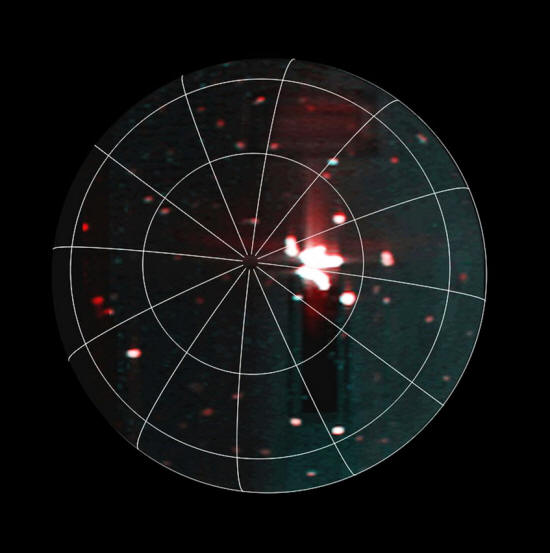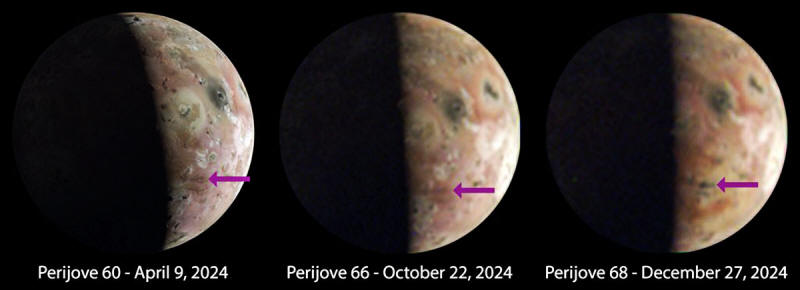|

by Jet Propulsion Laboratory
January 28, 2025
from
JPL-NASA Website

A massive
hotspot
- larger the Earth's Lake Superior -
can be seen just to the
right of Io's south pole
in this annotated image taken by the
JIRAM
infrared imager aboard NASA's Juno
on Dec. 27, 2024,
during the
spacecraft's flyby of the Jovian moon.
Credit: NASA/JPL-Caltech/
SwRI/ASI/INAF/JIRAM
Even by the standards of Io, the most volcanic celestial body in the
solar system, recent events observed on the Jovian moon are extreme.
Scientists with
NASA's Juno mission have discovered a volcanic hot
spot in the southern hemisphere of Jupiter's
moon Io.
The hot spot is not only larger than Earth's Lake
Superior, but it also belches out eruptions six times the total
energy of all the world's power plants.
The discovery of this massive feature comes
courtesy of Juno's Jovian Infrared Auroral Mapper (JIRAM)
instrument, contributed by the Italian Space Agency.
"Juno had two really close flybys of Io
during Juno's
extended mission," said the mission's principal
investigator, Scott Bolton of the Southwest Research
Institute in San Antonio.
"And while each flyby provided data on the
tormented moon that exceeded our expectations, the data from
this latest - and more distant - flyby really blew our minds.
This is the most powerful volcanic event ever
recorded on the most volcanic world in our solar system - so
that's really saying something."

Images of Io captured in 2024
by the JunoCam
imager aboard NASA's Juno
show
significant and visible surface changes
(indicated by
the arrows)
near the Jovian
moon's south pole.
These changes
occurred between
the 66th and
68th perijove,
or the point
during Juno's orbit
when it is
closest to Jupiter.
Credit: NASA/JPL-Caltech/SwRI/MSSS
Image
processing by Jason Perry
The source of Io's torment:
Jupiter...
About the size of Earth's Moon, Io is extremely
close to the mammoth gas giant, and its elliptical orbit whips it
around Jupiter once every 42.5 hours.
As the distance varies, so does the planet's
gravitational pull, which leads to the moon being relentlessly
squeezed.
The result:
immense energy from frictional heating that
melts portions of Io's interior, resulting in a seemingly
endless series of lava plumes and ash venting into its
atmosphere from the estimated 400 volcanoes that riddle its
surface.
Close Flybys
Designed to capture the infrared light (which isn't visible to the
human eye) emerging from deep inside Jupiter, JIRAM probes the gas
giant's weather layer, peering 30 to 45 miles (50 to 70 kilometers)
below its cloud tops.
But since NASA extended Juno's mission, the team
has also used the instrument to study the moons,
During its extended mission, Juno's trajectory passes by Io every
other orbit, flying over the same part of the moon each time.
Previously, the spacecraft made close flybys of Io in
December 2023
and
February 2024, getting within about 930 miles (1,500 kilometers)
of its surface.
The latest flyby took place on Dec. 27, 2024,
bringing the spacecraft within about 46,200 miles (74,400
kilometers) of the moon, with the infrared instrument trained on
Io's southern hemisphere.
Io Brings the Heat
"JIRAM detected an event of extreme infrared radiance - a massive
hot spot - in Io's southern hemisphere so strong that it saturated
our detector," said Alessandro Mura, a Juno co-investigator from the
National Institute for Astrophysics in Rome.
"However, we have
evidence what we detected is actually a few closely spaced hot spots
that emitted at the same time, suggestive of a subsurface vast magma
chamber system.
The data supports that this is the most intense
volcanic eruption ever recorded on Io."
The JIRAM science team estimates,
the as-yet-unnamed feature spans
40,000 square miles (100,000 square kilometers).
The previous record
holder was Io's
Loki Patera, a lava lake of about 7,700 square miles
(20,000 square kilometers).
The total power value of the new hot
spot's radiance measured well above 80 trillion watts.
Picture This
The feature was also captured by the mission's
JunoCam visible light
camera.
The team compared JunoCam images from the two previous Io
flybys with those the instrument collected on Dec. 27.
And while
these most recent images are of lower resolution since Juno was
farther away, the relative changes in surface coloring around the
newly discovered hot spot were clear.
Such changes in Io's surface
are known in the planetary science community to be associated with
hot spots and volcanic activity.
An eruption of this magnitude is likely to leave long-lived
signatures.
Other large eruptions on Io have created varied
features, such as pyroclastic deposits (composed rock fragments
spewed out by a volcano), small lava flows that may be fed by
fissures, and volcanic-plume deposits rich in sulfur and sulfur
dioxide.
Juno will use an upcoming, more distant flyby of Io on March 3 to
look at the hot spot again and search for changes in the landscape.
Earth-based observations of this region of the moon may also be
possible.
"While it is always great to witness events that rewrite the record
books, this new hot spot can potentially do much more," said Bolton.
"The intriguing feature could improve our understanding of volcanism
not only on Io but on other worlds as well."
More About Juno
NASA's Jet Propulsion Laboratory, a division of Caltech in Pasadena,
California, manages the Juno mission for the principal investigator,
Scott Bolton, of the Southwest Research Institute in San Antonio.
Juno is part of NASA's New Frontiers Program, which,
is managed at
NASA's Marshall Space Flight Center in Huntsville, Alabama, for the
agency's Science Mission Directorate in Washington.
The Italian
Space Agency (ASI) funded the Jovian InfraRed Auroral Mapper.
Lockheed Martin Space in Denver built and operates the spacecraft.
Various other institutions around the U.S. provided several of the
other scientific instruments on Juno.
|



